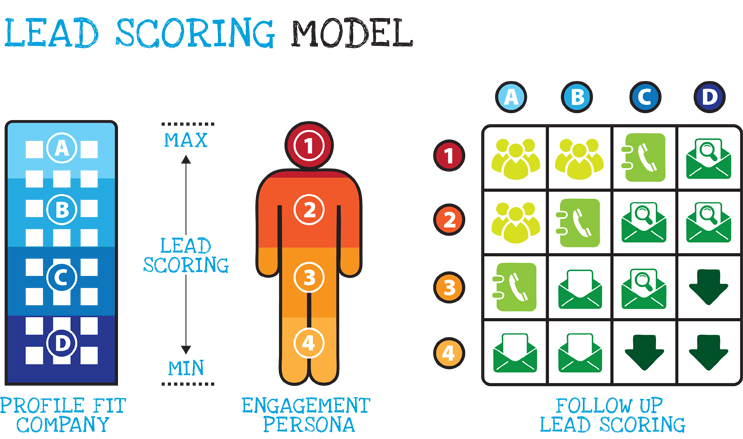Managers of small companies devote time to each customer. If the flow of potential customers is constantly growing and managers lack time to pay attention to each of them, it starts to be difficult to understand whether the client is ready for a deal and divide the effort and time between deals.
Lead scoring best practices are a marketing tool that allows assessing the potential of a transaction using the source data about a potential client of the company. In this article, we will explain why scoring is so necessary for businesses, talk about lead assessment parameters used in different niches, and find out how to set up lead scoring.
What is Lead Scoring?
This marketing technology was originally used in the banking sector. It is based on the assumption that the behavior of customers with identical social indicators can be predicted. To issue a loan, the bank calculates the reliability of the borrower, taking into account their credit history and financial situation. A reliable client will be quickly given a loan with soft return conditions; an unreliable client will either be denied or have to pay exorbitant interest rates. Banking lead scoring tools help financial institutions to minimize losses and increase profits. Why not use them in business?
In Internet marketing, lead scoring is an assessment of a client’s readiness for a deal. For example, how many times they visited the site, whether they left contact information, or subscribed to the newsletter. A score is given for each action and the final score is estimated based on the total amount. The higher the rating, the “warmer” the customer and the higher the likelihood that they are ready to buy.
Why Do You Need Lead Scoring Tools?
Scoring can save the time and energy of managers, organize work under a time crunch, evaluate the quality of lead sources and the efficiency of marketing and sales departments in general and individual employees in particular.

Process Optimization
Scoring reduces lead estimating time. It is enough to establish the basic conditions for the quality of the lead and the weight of these conditions in the final assessment. The manager submits an application in a CRM and ticks the basic conditions, and the scoring is done automatically. The assessment changes during the lead`s lifetime, you just need to specify additional criteria.
Thanks to the lead scoring system, forces are distributed more efficiently. After evaluation, leads automatically go to the right specialists. For example, if the evaluation shows the client is ready to buy, this is a qualified lead, so the sales department will deal with it. If the rating is still low, this is a marketing lead: the marketing department will continue working with it, gradually warming it up to complete readiness for a deal.
Assessment of Sources
Lead scoring techniques will help evaluate the conversion of application sources. For example, Facebook gives 100 leads every month, native advertising in topical publications gives 50. Thus, at first glance, it makes sense to invest in the former channel. But after scoring it turns out that the leads from the native ads are much more promising than from Facebook.
Analysis of Performance
Let’s imagine that one manager steadily shows results lower than others. Before firing the ineffective employee, you need to analyze the leads they work with. Perhaps the problem is not in the quality of work, but in the quality of leads – scoring will help you see that.
What are the Criteria for Scoring Leads?
Each niche has its own scoring parameters. For clarity, let’s look at lead scoring examples for various companies.
Scoring for an online school
To understand that the customer is ready to purchase or, conversely, wants to receive only free content, we need to evaluate the following parameters:
- valid contact information;
- viewed information about paid courses;
- registration for webinars;
- time spent on the webinars;
- communication with the manager.
Scoring for an online store
The purpose of the online store is to make a profit. To achieve this, you need to develop a strategy for working with leads of all categories: permanent and new. But it is impossible to please every customer at the same time, unless you lower the price of the products, in which case, you will not get the profit. Therefore, a balanced decision is to divide buyers into several categories according to, for example, the frequency of visits or the average monthly check.
A warm lead regularly visits the online store, looks at the same product category, opens and looks through newsletters. So, we evaluate the following parameters:
- frequency of visits to the site;
- the number of views of one product category;
- viewing delivery terms;
- opening mails;
- number of clicks in the letter;
- frequency of purchases;
- average check.
Using the CRM system, you can set instant notifications for managers when a user performs certain actions in a letter. This is convenient if the actions in the newsletters are your main indicator of scoring.
Scoring for b2b
Determining the seriousness of intentions in b2b transactions takes several steps. Check whether the client filled in the contact info properly (can they make decisions on the transaction?) Did the client study the offer carefully? Are they ready to buy in this price range? You can define the following conditions:
- proper contact information: name, phone, company name;
- contact position, whether this person is responsible for the transaction;
- reading a commercial offer;
- going to the site from a commercial offer;
- contact with the manager;
- the customer knows and agrees with the prices.
Important! Analyze your scoring options. Estimate conversions by marketing and qualified leads: if the difference is insignificant, adjust the parameters and see if the conversion is changing. This way you can understand how to score leads, and which of them are the most profitable.
Lead Scoring Software
The core of lead scoring is to collect points for each client’s action. For example, 1 point for visiting the site by reference, 5 points for Google search, 20 points for re-opening the site, 20 points for a completed transaction. Manual processing of operational information for each client is a long and inefficient process. Lead scoring in CRM is designed to perform this task. But not every CRM software has a developed lead scoring function.

When choosing a CRM, pay attention to the presence of such settings as:
- site visit;
- visiting certain pages;
- monitoring the number of visits;
- adding scores by geolocation, tags, the amount of data in the personal lead card, by product category;
- the downgrade of a lead when it does not meet your defined conditions;
- monitoring the number of open emails or clicks on links.
If CRM lead scoring does not provide this basic service, it’s better to look into another solution.
The Most Successful CRM Lead Scoring Models
Definitive Guide to Lead Scoring
- Integrate a marketing automation module into your CRM, if this functionality is not provided by default.
- Track the demographics of potential buyers. Of interest is all the available information: the place of work, position, annual income, etc.
- Add scores to a lead for any loyal actions: reading mail, visiting the site, activity on social networks, downloading trial versions of the product, demos, and other content.
- Check the effectiveness of your lead scoring model based on the results of the sales department. Take interest in how adequate your scoring system is for certain actions of the lead. Correct if necessary.
- Correctly configure the lead`s actions rating. Opening a homepage should not be evaluated in the same way as entering a product page.
- Plan scenarios for a lead to achieve a qualification level when it can be transferred to the sales department. In other words, what should a potential buyer do to move into the “active” category?
- Automate lead qualifications. For example, a request for a demo, or activating a test version of the product is a sufficient reason for the automatic lead.
- Practice negative scores for unsubscribing from the newsletter, searching for jobs on your site, negative comments on social networks.
- Don’t waste your time on unpromising leads. For example, if when downloading content, the lead introduced themselves as a student, thus, there is reason to doubt their purchasing power.
- Practice downgrading and disqualification of leads that are formally considered active but do not show any interest in interacting.
- Review your scoring system regularly. If a large number of potentially active leads does not result in sales growth, then there is a reason to revise the qualification algorithm.
Conclusion
The scoring of leads in digital marketing is a forecast of whether the deal will be successfully completed or not.
To evaluate scoring in different marketing niches, different parameters are used. For example, an online store looks at how a client responds to an email newsletter, and a b2b company looks at whether they have studied the offer and prices.
Scoring will help the company:
- to save time on lead assessment;
- to work with the most effective leads with limited time;
- analyze lead sources;
- synchronize and optimize the work of marketing and sales managers.
It is useful to test the evaluation parameters and verify the conversion of high-scoring and low-scoring leads – this will help create a more effective scoring.
Do not ignore the low-scoring leads: the right marketing strategy will help to gradually turn them into valuable customers. Email, web push, SMS, and Facebook Messenger chatbots in SendPulse will help you with this.
Using a CRM system such as Nimble in Internet marketing will provide your business with a stable sales growth based on a statistical analysis of the behavior of each potential buyer.


